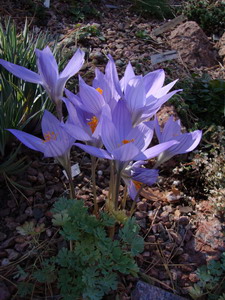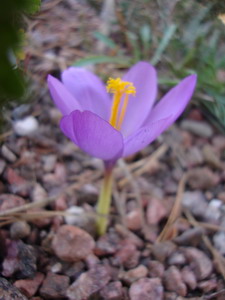Topsy turvy Crocuses...

Autumn is imbued with intimations of mortality: dying leaves, dormancy, doom, gloom, Hallowe'en colors and ghosts and spooks: Boo! Gardeners know another side of this "season of mists and mellow fruitfulness": there are a number of plants that only begin blooming in September, with one or another species coming on until the spring: Hellebores, crocuses, cyclamen and witch hazels are all plants that have a different notion of the growing season. It's their spring right now! A well stocked collection of any of these genera begins with heavy bloom in October and one or another will keep blooming right until the hot days of late spring when they go dormant (so to speak) for the summer doldrums. These are my kind of plants! Crocuses for most of us means the bright orangy-yellow Crocus flavus or C. ancyrensis among a host of others, not to mention the Dutch giants derived from C. vernus. Although pitifully few Coloradoans grow them, crocuses will thrive almost anywhere they are planted in a Colorado garden: dry or wet, sunny or shady. They love it here. Now is a great time to plant these spring bloomers for a splash of color in February and March. There are another group of true crocuses that wait until October to put on their show. These you must order early in the season and plant in September preferably. Denver Botanic Gardens boasts wonderful plantings of these in many gardens: they are among the largest flowered plants in their genus and have flowers of a luminous shades of lavender, purple and occasionally white. Ten days ago we had a precocious bout of winter that froze many leaves and diminished our autumn beauty. But I have never seen the autumn crocuses bloom more spectacularly than they have the last few weeks. I am not talking about the pink Colchicums that go by that name (they are mostly done and are in the Lily family and have six stamens: true crocuses are related to irises and have only three stamens!). Above you have Crocus speciosus, the commonest and bluest of the autumn crocus which is blooming in the east west pathway and the Rock Alpine Garden right now. Below is C. nudiflorus in my own home garden. An even darker C. medius will be blooming the next few weeks in the Rock Alpine Garden. Remind me to order more of these and the rest next year for my garden! To walk into a garden where dozens of unearthly, fluted goblets of autumn crocuses are gently trembling in the autumn breeze is heavenly. It's as though they are toasting the start of the crocus season with their beakers, full of sky blue or evening lavender. Cheers! 
Add new comment